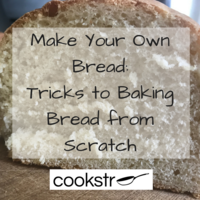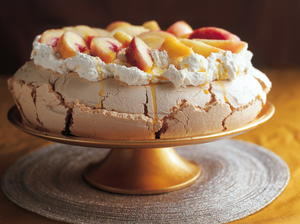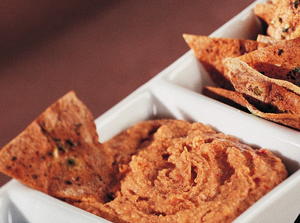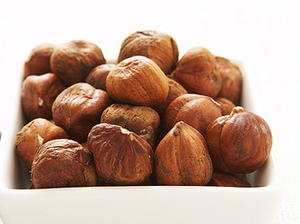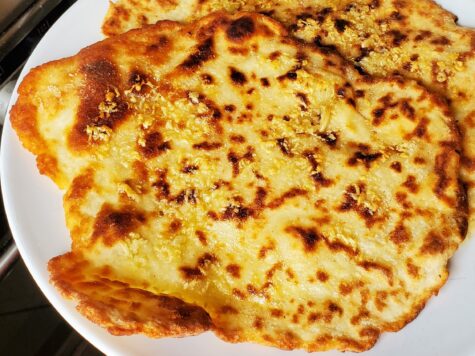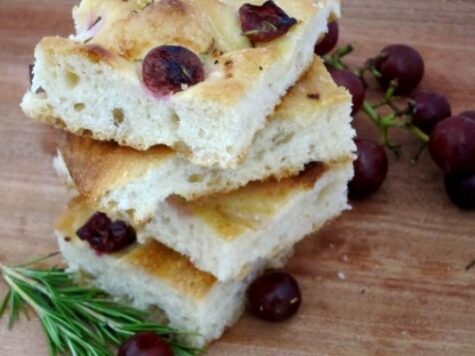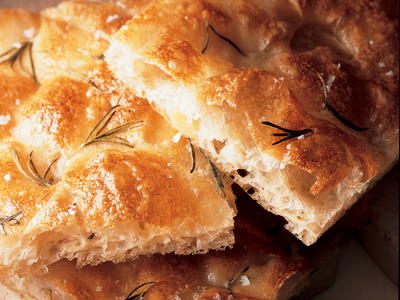
Rosemary Focaccia Sheet
This image courtesy of Gentl & Hyers/Edge
Editor’s Note: If you’ve been baking bread for a while, then you might be ready to branch out and try something new. With this recipe for Rosemary Focaccia Sheet, you can create the perfect accompaniment to soups and stews! This bread is also perfect for snacking and will be a hit at your next casual get-together with friends and family.
This intriguing dough presents an apparent contradiction: it is incredibly light yet moist and satisfyingly chewy. Consider the percentage of water in this dough! In relation to the flour, it has 113.5 percent water, making it the highest percentage of any dough in this book. Who would have thought it even possible to make a dough this wet and still produce bread? And that is the secret of its incredible texture. The exceptionally high amount of water keep the gluten in the flour from breaking down during the very long beating process. This enables the dough to develop into long stretch strands that hold the air and give a chewy texture. It will remain a soupy batter until toward the very end of the twenty-minute beating, when it suddenly metamorphoses into a shiny, smooth, incredibly elastic dough.
I adapted this recipe from my favorite neighborhood bakery, the Sullivan Street Bakery in New York City. I love the dough so much I prefer it as the main feature, simply sprinkled with a little fruity olive oil and rosemary, sparkling with fleur de sel or sea salt. I also love it with the simple addition of oil-poached garlic cloves (see the variation below).
OccasionCasual Dinner Party
Recipe CourseSide Dish, Snack
Five Ingredients or LessYes
MealBrunch, Dinner, Lunch, Snack
Taste and TextureChewy, Crisp, Herby, Salty
Type of DishBread, Focaccia
Ingredients
- 2 ¾ cups/ 13.6 ounces/ 390 grams unbleached all purpose flour (use only Gold Medal, King Arthur, or Pillsbury)
- 3/8 teaspoon/ 1.2 grams instant yeast
- 2 liquid cups minus 2 tablespoons/ 15.5 ounces/442 grams water, at room temperature (70°F to 90°F)
- ¾ teaspoon/ 3 grams sugar
- ¾ teaspoon/ 5.2 grams salt
- 2 tablespoons plus 2 teaspoons, divided/ 5.2 grams extra virgin olive oil
- 2 teaspoons fresh rosemary needles or dried rosemary (1/2 teaspoon for dried)
- ¼ teaspoon fleur de sel or sea salt
- A heavy-duty stand mixer with paddle attachment
- A half sheet pan (12 inches by 17 inches)
- A baking stone OR baking sheet
Learn how to make your own bread when you take a look at these Make Your Own Bread: 6 Tricks to Baking Bread from Scratch
Instructions
Oven Temperature: 475 degees F
Mix the dough. In the mixer bowl, with the paddle attachment on low speed (#2 if using a KitchenAid), combine the flour and the yeast. With the mixer running, gradually add the water, mixing just until the dough comes together, about 3 minutes. It will be very soupy. Increase the speed to medium (#4 KitchenAid) and beat until the dough is transformed into a smooth, shiny ball, about 20 minutes.
Add the sugar and salt and beat until they are well incorporated, about 3 minutes.
Let the dough rise. Using an oiled spatula or dough scraper, scrape the dough into a 1 ½ -quart dough-rising container or bowl, lightly greased with cooking spray or oil. The dough will look like melted mozzarella. Lightly spray or oil the top of the dough. Cover the container with a lid or plastic wrap. With a piece of tape, mark the side of the container at approximately where double the height of the dough would be. Allow the dough to rise (ideally at 75 degrees F to 80 degrees F) for about 4 hours or until it has at least doubled.
Shape the dough and let it rise. Coat the sheet pan with a heaping tablespoon of the olive oil. Pour the dough onto it—it will be thin enough to pour but very stretchy. Coat your hands with a little of the remaining olive oil and spread the dough as thin as possible without tearing it. Let it relax for 10 minutes, then spread it to almost fill the entire sheet, trying to maintain the bubbles in the dough. (If the dough is still very elastic and resists stretching, allow it to rest for another 10 minutes.)
Cover the pan with a large plastic box or greased plastic wrap and allow to rise until double its original volume, about 1 ½ to 2 hours.
Preheat the oven. Preheat the oven to 475 degrees F 1 hour before baking. Have an oven shelf at the lowest level and place a baking stone or baking sheet on it before preheating.
Sprinkle on the toppings and bake the focaccia. Uncover the dough and drizzle the remaining olive oil evenly over it. With oiled or wet fingertips, deeply dimple the dough. Sprinkle evenly with the rosemary and salt. Place the pan directly on the hot stone or hot baking sheet and bake for 12 to 13 minutes or until the top is golden. Remove from the oven and drizzle on a little extra virgin olive oil, if desired. Serve immediately.
Variation: Focaccia with Pockets of Garlic
If you love garlic, meltingly soft pockets of poached garlic added to the dough make a welcome addition to the crisp, light bread. Be sure to prepare the garlic ahead so that you can use the garlic-infused oil for the focaccia. This method of “roasting” garlic also makes it milder than the usual oven roasting, as long as you do not allow it to brown. In early summer, garlic scapes, the newly forming garlic cloves, are available at the farmer’s market. I like to use these tiny tips of pinky-size garlic pearls, which are exceptionally sweet and mild.
Ingredients:
1 large head of garlic (about 2 ½ inches wide)
About 1 cup extra virgin olive oilMethod:
* Peel the garlic cloves: you should have about 2/3 cup. Place them in a small saucepan and cover them with the olive oil, adding more if the oil does not cover the garlic completely.* Cover the pan and leave it partially uncovered if the oil starts to bubble. Bring the oil just to a boil over low heat. Turn down the heat as low as possible (use a heat diffuser if necessary) and poach the garlic at a bare simmer (if the oil starts to bubble too much, partially uncover the pan) for about 20 to 30 minutes, until a cake tester or metal skewer inserted in it goes in fairly easily but not so soft that it turns to mush. Smaller cloves may take only 15 minutes, so remove them as they are softened. (You can also poach garlic by placing the partially covered [ovenproof] pan in a preheated 250°F oven for the same amount of time.)
* Lift the garlic from the oil with a slotted spoon, and let the oil cool. Use the garlic-infused oil in place of the olive oil to prepare the focaccia, if desired, and refrigerate the remainder for other uses.
* Slice any large garlic cloves lengthwise in half or in thirds. After pouring the dough onto the sheet pan, make about 32 evenly spaced depressions in the dough with your fingertip (8 rows of 4 across), and gently press a garlic clove into each one. As the dough rises, it will partially enclose the garlic and protect it from becoming any darker than golden during baking.
Time Schedule
Rising Time: About 5 hours
Baking Time: 13 minutes
Understanding
The sugar and salt are added a the end of beating to given the gluten a chance to develop fully so that the baked focaccia will be nice and chewy.
The Dough Percentage
Flour: 100%
Water: 113.5%
Yeast: 0.3%
Salt: 1.3%
Oil: 12.7%
2003 Rose Levy Beranbaum
YOUR RECENTLY VIEWED RECIPES
We are adding your Comments. ![]()
Thank you! Your comment has been added.
We are sorry. There was an error tyring to post your rating and review.
Your comment will appear after our editors have had a chance to review it.

